Injury to the face can lead to a variety of defects. They can present as acute defects soon after injury or as delayed presentation, weeks to months after injury. These defects result in cosmetic disfigurement or functional problems or both.
Common causes of facial defects are Road traffic accidents, burns specially electric and chemical burns, gunshot injuries, animal and human bites and assault.
Soon after injuries facial defects can present with concomitant life threatening injuries which need to be dealt first before final reconstruction of these defects. Acute defects range from loss of soft tissue or bone from any part of the face, like forehead, eyelids, nose, cheek, mouth, and amputation of nose or ear.
Delayed defects can present weeks or months after primary injury and can range from non-healed wounds to healed areas of soft tissue loss of any part of the face with or without exposed bones through defects.
Management of these defects depends on their causes, time of presentation, condition of patient and wounds, site and size of defect and available treatment options.
In concomitant life threatening injuries facial wounds are dealt with wound wash, dressings, antibiotics till patient condition allows for definitive management.
In stable patients with no other injuries, defects are dealt accordingly.
Amputation of nose and ear can be dealt with reimplantation surgery of placing nose and ear back to their place by microvascular surgery if brought to hospital early and the amputated part is in good condition. Reconstruction of other defects require skin grafts, loco regional or free flaps (tissue transferred from other parts of the body along with its blood supply) , bone and cartilage grafts, alloplastic materials and more than one surgeries are required for complex defects.
Any patient with traumatic facial defect should be brought to hospital as soon as possible and expert plastic surgery consult should be taken to evaluate the defects
FAQ
1. What are functional problems associated with facial defects?
There may be problems with eating, smiling, drooling of saliva from mouth, vision, hearing depending upon the area involved.
2. Will the face look the same as before trauma after plastic surgery?
Face will look better than its with defect but does not look completely normal
3. What are the chances of success in facial defects?
Chances of success are good in expert hands.
4. What about the area from where you take graft or flap?
Area from where thin skin graft is taken is healed in 2 weeks, area from full thickness skin graft is taken or from where flap is taken is closed with sutures and healed in 10 days or two weeks time.
5. What if the nose and ear were not reconstructed by surgery?
Good prosthetic (made with artificial material) ear and nose are available nowadays
Written by : Dr. Fahmina
Copyrights: Pakistan association of Plastic Surgeons

